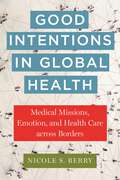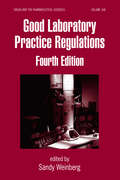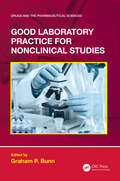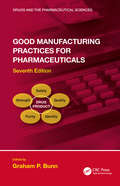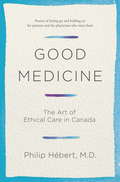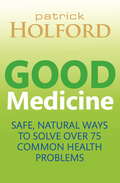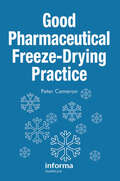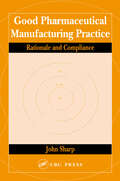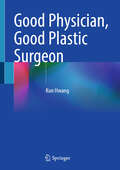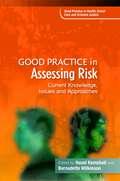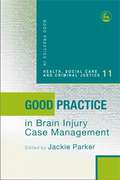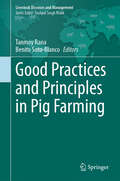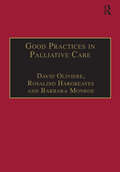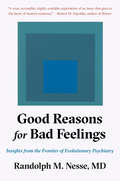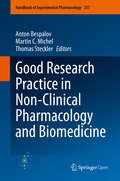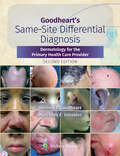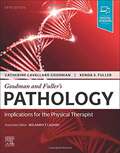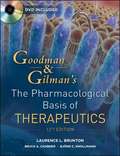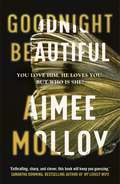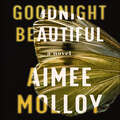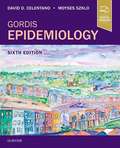- Table View
- List View
Good Intentions in Global Health: Medical Missions, Emotion, and Health Care across Borders (Anthropologies of American Medicine: Culture, Power, and Practice)
by Nicole S. BerryExplores informal global health action and the importance of intentions of those who volunteerIn the past two decades, medical missions have gained popularity among medical professionals, who view these excursions as important ethical interventions. Indeed, the notion of giving back by volunteering in rural or impoverished communities is celebrated as an ideal act of selflessness, one whose effects are unquestionably beneficial to those being served.Good Intentions in Global Health is a groundbreaking exploration of the growing realm of informal global health engagement, shedding light on the intricate interplay between intentions, emotions, and ethical considerations. Drawing on fieldwork in Guatemala, Nicole S. Berry investigates those who volunteer for short-term medical missions, revealing how the intent to do good shapes their everyday understandings of their own actions taken in the global health domain.Berry uncovers how the glorification of medical missions can obscure problems that stem from North American clinicians doctoring in places where they typically do not understand the context. The short-term nature of missions also means that volunteers are not privy to the long-term effects of their actions—the potential harms that may arise from a lack of sustained follow-up care or the utter absence of documentation that they were even there. By relying on gut instincts to reassure themselves that they are doing good, volunteers often bypass a comprehensive assessment of the ethical dimensions underlying their global health work.Good Intentions in Global Health shows why desires and emotions are increasingly important to contemporary global health. She makes the case that we must pay attention to volunteers’ perceptions of their work, however wrongheaded or naïve, in order to truly influence global health on the ground.
Good Laboratory Practice Regulations (Drugs and the Pharmaceutical Sciences)
by Sandy WeinbergRecent changes in the interpretation and enforcement of 21 CFR Part 11 have shifted the focus of Good Laboratory Practice (GLP) regulations to concentrate on the acceptance of electronic signatures, the archiving of data, the security of electronic documents, and the automation of laboratory procedures. This all-encompassing Fourth Edition addresse
Good Laboratory Practice for Nonclinical Studies (Drugs and the Pharmaceutical Sciences)
by Graham P BunnThe GLP regulations have been enacted since 1978 and are currently under a proposed FDA amendment to revise terminology and accommodate other changes relating to advances in technology related to the industry. This book provides a unique opportunity to access interpretation of the 21CFR58 regulatory requirements from leading industry experts with a vast knowledge and expertise in their fields. The approach used takes the regulations, provides interpretations and references to examples and regulatory actions. Data integrity and the use of electronic systems in compliance with 21CFR11 Electronic Records: Electronic Signatures are also discussed. • Unique volume covering FDA inspections of GLP facilities • Provides a detailed interpretation of GLP Regulations • Presents the latest on electronic data management in GLP • Describes GLP and computer systems validation • Can be referenced repeatedly in supporting daily hands on implementation of the CFR requirements
Good Manufacturing Practices for Pharmaceuticals, Seventh Edition (Drugs and the Pharmaceutical Sciences)
by Graham P. BunnThis book provides insight into the world of pharmaceutical quality systems and the key elements that must be in place to change the business and organizational dynamics from task-oriented procedure-based cultures to truly integrated quality business systems that are self-detecting and correcting. Chapter flow has been changed to adopt a quality systems organization approach, and supporting chapters have been updated based on current hot topics including the impact of the worldwide supply chain complexity and current regulatory trends. Key Features: Presents insight into the world of pharmaceutical quality systems Analyzes regulatory trends and expectations Includes approaches and practices used in the industry to comply with regulatory requirements Discusses recent worldwide supply chain issues Delivers valuable information to a worldwide audience regarding the current GMP practices in the industry
Good Medicine
by Philip HebertAward-winning physician Philip C. Hébert creates a brave and intimate portrait of the complex ethical imperatives at the heart of good medicine: doctors do not have all the answers; patients must be heard; and their needs, desires, fears, and experiences must be reflected in how practitioners look after them. Medical science continues to advance to previously unimagined heights in its diagnostic and treatment capabilities. With these advances, however, come unexpected ethical dilemmas for practitioners, patients, and families. In Good Medicine, Dr. Hébert approaches these questions of pressing and fundamental importance from the dual point of view of acclaimed physician and long-time patient. With remarkable balance and sensitivity, he explores a range of politically, constitutionally, and ethically contentious matters, including assisted suicide, treatment refusal and suspension, and the overall allocation of medical resources. Hébert pairs his artful analysis with the real-life, often deeply moving stories of those who have lived these challenges. Hébert offers piercing and compassionate insight into the relationship between patients and medical professionals, and guides readers towards the open and empathetic communication needed to ensure good medicine for everyone.From the Hardcover edition.
Good Medicine: Safe, Natural Ways to Solve Over 75 Common Health Problems
by Patrick HolfordThis fascinating, practical book is for everyone who values a natural approach to health. Good Medicine covers over 75 of the most common health problems and offers simple things you can do to prevent or reverse that health condition. They are all tried and tested and have been proven to work, both in clinical research but also in practice, with people like you. Each condition includes the following information:* Five or six good medicine solutions - how each solution works and what you need to do* Best and worst foods - which foods you should eat and those you should avoid* Best supplements - the most appropriate supplementsYou will also find revealing case studies and general advice on the habits that will help you stay healthy, from reducing your stress level to improving your diet and how to monitor which changes make the biggest difference to you. Covering everything from everyday ailments such as the common cold to more serious illnesses, this comprehensive book is the perfect guide to natural approaches to health.
Good Medicine: Safe, natural ways to solve over 75 common health problems
by Patrick Holford BSc, DipION, FBAThis fascinating, practical book is for everyone who values a natural approach to health. Good Medicine covers over 75 of the most common health problems and offers simple things you can do to prevent or reverse that health condition. They are all tried and tested and have been proven to work, both in clinical research but also in practice, with people like you. Each condition includes the following information:* Five or six good medicine solutions - how each solution works and what you need to do* Best and worst foods - which foods you should eat and those you should avoid* Best supplements - the most appropriate supplementsYou will also find revealing case studies and general advice on the habits that will help you stay healthy, from reducing your stress level to improving your diet and how to monitor which changes make the biggest difference to you. Covering everything from everyday ailments such as the common cold to more serious illnesses, this comprehensive book is the perfect guide to natural approaches to health.
Good Pharmaceutical Freeze-Drying Practice
by Peter CameronThis text is devoted to pharmaceutical freeze-drying in all its forms and in all its technological variations. Whether you freeze-dry nonsterile tablets or you lyophilize injectables, this book covers all the technological and regulatory requirements. Written by a panel of leading practitioners in the pharmaceutical industry -- production experts,
Good Pharmaceutical Manufacturing Practice: Rationale and Compliance
by John SharpWith over twenty different official regulatory statements worldwide on Good Manufacturing Practice (GMP) for pharmaceutical, drug, or medicinal products, two stand out as being the most influential and most frequently referenced. Bridging the gap between U.S. regulations and European Good Manufacturing Practice guidelines, Good Pharmaceuti
Good Physician, Good Plastic Surgeon
by Kun HwangThis book is based on over 100 editorials published in various international academic journals. Within its pages, the author engages in discussions with esteemed plastic surgeons, exploring the qualities that define a good plastic surgeon, the intricate connection between anatomy and plastic surgery, the concept of beauty, the process of aging, and the interplay between arts and plastic surgery. Each case presented in the book is both captivating and educational, with the author thoughtfully including a corresponding figure or schema for visual reference. This book promises to be an invaluable resource, particularly for young plastic surgeons or those undergoing plastic surgery training.
Good Practice in Assessing Risk
by Bernadette Wilkinson Edited by Hazel KemshallMaintaining a balance between managing and assessing risk and upholding the required high standards of practice in health and social care can be demanding, particularly in the current climate of increased preoccupation with the difficult tensions between rights, protection and risk-taking. Good Practice in Assessing Risk is a comprehensive guide to good practice for those working with risk, covering a wide variety of health, social care and criminal justice settings including child protection, mental health, work with sex offenders and work with victims of domestic violence. The contributors discuss a range of key issues relating to risk including positive risk-taking, collaborating with victims and practitioners in the design of assessment tools, resilience to risk, and defensibility. The book also explores the role of bureaucracy in hindering high quality professional practice, complex decision-making in situations of stress or potential blame, and involving service users in assessment. This book reflects the latest policy and practice within health, social care and criminal justice and will be an invaluable volume to all professionals working in these fields.
Good Practice in Brain Injury Case Management
by Jackie ParkerBrain injury case management involves the care and support of brain-injured individuals and their families in a range of areas, from personal injury litigation to the planning of treatment and therapy regimes. Good Practice in Brain Injury Case Management provides a guide to effective case management, outlining all the key issues that professionals working with brain-injured people will need to know, from understanding what brain injury actually is and how it feels to experience it to strategies for rehabilitation, assessing risk and implementing support plans. The contributors are drawn from a wide range of disciplines, including social work, neuropsychology, occupational therapy and legal practice, and offer information and advice in clear jargon-free. This is an essential handbook for case managers and all other professionals working with brain injured people.
Good Practice in Pediatric and Adolescent Gynecology
by Anna Maria FulghesuThis volume focuses on a period in women's lives that is particularly important in the context of preventing major sexual and reproductive diseases. Recommendations by the Italian Society of Pediatric and Adolescent Gynecology, form the basis of this up-to-date and practical book. Experts in the field comprehensively cover all the relevant topics in pediatric and adolescent gynecology, such as pubertal disorders, genital malformations and menstrual cycle disorders. The book will prove a valuable and practice-oriented tool for, gynecologists, pediatricians and endocrinologists, as well as researchers and practitioners interested in the topic.
Good Practices and Principles in Pig Farming (Livestock Diseases and Management)
by Benito Soto-Blanco Tanmoy RanaThis book illustrates the importance and significance of improvement strategies for pig farming. It covers various topics such as proper handling, general health care management, stress management criteria, and entrepreneur development through pig farming. The book also provides current useful information about the improvement through genetic enhancement, stress monitoring, and environmental impact on pig production and management. The behavior, welfare, and mycotoxins control in feedstuffs is elaborately described to make the book more lucrative. The chapters also describe recent advancements in pig farming, business management, and entrepreneurship for better pig improvement. Finally, the book also elucidates a comprehensive as well as representative description of the general health, management, and productive performance of pigs. The book is helpful for undergraduates, postgraduates, research scholars, academicians, farm managers, field veterinarians, and meat plant officers.
Good Practices in Health Financing
by Hugh R. Waters Pablo Gottret George SchieberFor humanitarian reasons and the concern for households' economic and health security, the health sector is at the center of global development policy. Developing countries and the international community are scaling up health systems to meet the Millennium Development Goals (MDGs) and are improving financial protection by securing long-term support for these gains. Yet money alone cannot buy health gains or prevent impoverishment due to catastrophic medical bills; well structured, results-based financing reforms are needed. Unfortunately, global evidence of "successful" health financing policies that can guide the reform effort is very limited and therefore the policy debate is often driven by ideological, one-size-fits-all solutions. 'Good Practices in Health Financing: Lessons from Reforms in Low- and Middle-Income Countries' attempts to begin to fill the void by systematically assessing health financing reforms in nine low- and middle-income countries that have managed to expand their health financing systems to both improve health status and protect against catastrophic medical expenses. The participating countries are: Chile, Colombia, Costa Rica, Estonia, the Kyrgyz Republic, Sri Lanka, Thailand, Tunisia, and Vietnam. The study seeks to identify common enabling factors of their good performance. While the findings for each country are important, collectively they send a clear message to the global community that more attention is needed to define "good practice" and then to evaluate and disseminate the global evidence base.
Good Practices in Palliative Care: A Psychosocial Perspective
by David Oliviere Rosalind HargreavesA team of two practitioners in psychosocial palliative care and an academic have drawn together the work of twenty-eight highly experienced practitioners. Good Practices in Palliative Care : a psychosocial perspective provides detailed descriptions of innovatory practices and how they were developed, together with clear practice principles. This unique contribution to palliative care literature is suitable for a wide range of health and social care professionals at student and experienced levels and is written in a user-friendly style.
Good Reasons for Bad Feelings: Insights from the Frontier of Evolutionary Psychiatry
by Randolph M. NesseA founder of the field of evolutionary medicine uses his decades of experience as a psychiatrist to provide a much-needed new framework for making sense of mental illness.Why do I feel bad? There is real power in understanding our bad feelings. With his classic Why We Get Sick, Dr. Randolph Nesse helped to establish the field of evolutionary medicine. Now he returns with a book that transforms our understanding of mental disorders by exploring a fundamentally new question. Instead of asking why certain people suffer from mental illness, Nesse asks why natural selection has left us all with fragile minds. Drawing on revealing stories from his own clinical practice and insights from evolutionary biology, Nesse shows how negative emotions are useful in certain situations, yet can become overwhelming. Anxiety protects us from harm in the face of danger, but false alarms are inevitable. Low moods prevent us from wasting effort in pursuit of unreachable goals, but they often escalate into pathological depression. Other mental disorders, such as addiction and anorexia, result from the mismatch between modern environment and our ancient human past. And there are good evolutionary reasons for sexual disorders and for why genes for schizophrenia persist. Taken together, these and many more insights help to explain the pervasiveness of human suffering, and show us new paths for relieving it by understanding individuals as individuals.
Good Research Practice in Non-Clinical Pharmacology and Biomedicine (Handbook of Experimental Pharmacology #257)
by Martin C. Michel Thomas Steckler Anton BespalovThis open access book, published under a CC BY 4.0 license in the Pubmed indexed book series Handbook of Experimental Pharmacology, provides up-to-date information on best practice to improve experimental design and quality of research in non-clinical pharmacology and biomedicine.
Goodheart's Same-Site Differential Diagnosis: Dermatology for the Primary Health Care Provider
by Herbert GoodheartRecognizing that many skin disorders have a predilection to occur at specific sites, Goodheart’s Same- Site Differential Diagnosis, 2nd Edition, is organized in a convenient, head-to-toe fashion so physicians can quickly reach a differential diagnosis between skin disorders that are often confused with each other. Drs. Herbert P. Goodheart Mercedes E. Gonzalez presents hundreds of full-color images of common skin disorders side by side with their clinical look-alikes or other diagnostic possibilities that occur at the same anatomic site for easy comparison. Ideal for the non-dermatologist and dermatologists in training, this fully updated, highly illustrated text is invaluable for all clinicians who are on the front line of diagnosing and treating skin disorders.
Goodman and Fuller's Pathology: Implications for the Physical Therapist
by Kenda S. Fuller Catherine Cavallaro KelloggThe only pathology textbook written specifically for physical therapy, this edition continues to provide practical and easy access to information on specific diseases and conditions as they relate to physical therapy practice. Coverage includes guidelines, precautions, and contraindications for interventions with patients who have musculoskeletal or neuromuscular problems, as well as other medical conditions such as diabetes or heart disease. Logically organized content offers at-a-glance access to essential information on common illnesses, diseases, adverse drug effects, organ transplantation, laboratory values, and more to ensure the most reliable and effective physical therapy for patients.
Goodman and Gilman's The Pharmacological Basis of Therapeutics (Twelfth Edition)
by Louis Sanford Goodman Laurence L. Brunton Bruce Chabner Bjorn Knollman"This 12th edition of the most authoritative book in pharmacology is the best both in content and physical appearance. . . . This edition of Goodman & Gilman's continues to be the most authoritative and widely used resource bridging the discipline of pharmacology with therapeutics. Moreover, readers will find this edition to be substantially improved from past editions in both content and physical appearance. "--Doody's Review Service The most universally respected and read medical text in all of pharmacology, Goodman & Gilman's The Pharmacological Basis of Therapeutics represents the pinnacle of authority and accuracy in describing the actions and uses of therapeutic agents in relation to physiology and pathophysiology. Goodman & Gilman's careful balance of basic science and clinical application has guided thousands of practitioners and students to a clear understanding of the drugs essential to preventing, diagnosing, and treating disease. Enriched by a new full-color presentation and updated to reflect all critical new developments in drug action and drug-disease interaction, the twelfth edition includes more than 440 color illustrations depicting key principles and actions of specific pathways and therapeutic agents. The companion DVD includes all the images and tables in the text along with narrated animations. Goodman & Gilman's The Pharmacological Basis of Therapeutics, 12e is divided into nine sections, covering: General Principles Neuropharmacology Modulation of Cardiovascular Function Inflammation, Immunomodulation, and Hematopoiesis Endocrine Pharmacology Gastrointestinal Pharmacology Chemotherapy of Infectious Disease Chemotherapy of Neoplastic Diseases Special Systems Pharmacology More than a textbook, Goodman & Gilman's is a working template for the effective and rational prescribing of drugs in daily practice.
Goodnight, Beautiful: The utterly gripping psychological thriller full of suspense
by Aimee MolloyA handsome psychotherapist. His lonely wife. And in his home office ceiling, a vent. You'd listen too, wouldn't you?...For fans of The Silent Patient and The Couple Next Door, comes this irresistible new thriller from the New York Times bestseller that will have you gripped to the edge of your seat.Newlyweds, Sam Statler and Annie Potter are ready to begin their lives together in a small town in upstate New York. Whilst Annie spends most of her time alone, Sam, her therapist husband, works long hours in his home office, tending to the egos of his mostly female clientele.Little does Sam know that through a vent in the ceiling, every word of his sessions can be heard from the room upstairs. The pharmacist's wife, contemplating a divorce. The well-known painter whose boyfriend doesn't satisfy her in bed. Who could resist eavesdropping?Everything is fine until the French girl in the green Mini Cooper shows up, and Sam disappears into thin air, throwing a wrench into Sam and Annie's happily ever after.YOUR FAVOURITE AUTHORS LOVE GOODNIGHT, BEAUTIFUL . . .'Goodnight Beautiful is a thrill-ride packed with twists. Enthralling, sharp, and clever, this book will keep you guessing' SAMANTHA DOWNING, bestselling author of MY LOVELY WIFE'The most suspenseful novel you'll read this year' A. J. FINN, bestselling author of THE WOMAN IN THE WINDOWREADERS LOVE GOODNIGHT, BEAUTIFUL . . .'This book was fabulous! It was dark and super twisty and absolutely addicting. I read it in less than 24 hours and didn't want to put it down to sleep!''This kept me gripped and desperate to keep reading''I loved this book, brilliantly crafted and an immersive plot that was full of surprises''Definitely one of the best books I've read recently. An absolute corker that justly deserves five stars''An exciting domestic thriller that started of as a literal rollercoaster and never slowed down''If you love a story full of twists and mystery then this is the one for you!'
Goodnight, Beautiful: The utterly gripping psychological thriller full of suspense
by Aimee Molloy'Goodnight Beautiful isn't only the most suspenseful novel you'll read this year; it's likely to be the funniest, too. I wish that every book, in every genre, were as deeply imagined and fully inhabited as this one.' A. J. FINN, bestselling author of THE WOMAN IN THE WINDOW'Aimee Molloy is a magician. With Goodnight Beautiful, she will artfully deceive you while holding you firmly in her grasp...What begins as a sexy, smart domestic thriller turns out to be so much more. If you think you've figured this one out, think again: Molloy will be three steps ahead of you all the way through.' CRISTINA ALGER 'Psychological thriller fans won't want to miss this one.' - PUBLISHER'S WEEKLYFrom 'master of clever misdirection' (Kirkus Reviews) Aimee Molloy, author of the New York Times bestseller The Perfect Mother, comes an irresistible psychological thriller featuring a newly married woman whose life is turned upside down when her husband goes missing.A HANDSOME PSYCHOTHERAPIST, HIS LONELY WIFE, AND IN HIS HOME OFFICE, A CEILING VENT. . . YOU'D LISTEN TOO, WOULDN'T YOU?Newlyweds, Sam Statler and Annie Potter are ready to begin their lives together in a small town in upstate New York. Whilst Annie spends most of her time alone, Sam, her therapist husband, works long hours in his home office, tending to the egos of his mostly female clientele.Little does Sam know that through a vent in the ceiling, every word of his sessions can be heard from the room upstairs. The pharmacist's wife, contemplating a divorce. The well-known painter whose boyfriend doesn't satisfy her in bed. Who could resist eavesdropping? Everything is fine until the French girl in the green Mini Cooper shows up, and Sam disappears into thin air, throwing a wrench into Sam and Annie's happily ever after. This is a brilliant story of a whirlwind marriage in which untold secrets and games threaten to destroy them both.(P)2020 Harper Audio
Gordis Epidemiology
by Moyses Szklo David D. CelentanoFrom the Department of Epidemiology at Johns Hopkins University and continuing in the tradition of award-winning educator and epidemiologist Dr. Leon Gordis, comes the fully revised 6th Edition of Gordis Epidemiology. This bestselling text provides a solid introduction to basic epidemiologic principles as well as practical applications in public health and clinical practice, highlighted by real-world examples throughout. New coverage includes expanded information on genetic epidemiology, epidemiology and public policy, and ethical and professional issues in epidemiology, providing a strong basis for understanding the role and importance of epidemiology in today’s data-driven society.
Gorilla and the Bird: A Memoir of Madness and a Mother's Love
by Zack McdermottThe story of a young man fighting to recover from a devastating psychotic break and the mother who refuses to give up on him Zack McDermott, a 26-year-old Brooklyn public defender, woke up one morning convinced he was being filmed, Truman Show-style, as part of an audition for a TV pilot. This was it - his big dreams were finally coming true. Every passerby was an actor; every car would magically stop for him; everything he saw was a cue from "The Producer" to help inspire the performance of a lifetime. After a manic spree around Manhattan, Zack, who is bipolar, was arrested on a subway platform and admitted to Bellevue Hospital. So begins the story of Zack's freefall into psychosis and his desperate, poignant, often darkly funny struggle to claw his way back to sanity, regain his identity, and rebuild some semblance of a stable life. It's a journey that will take him from New York City back to his Kansas roots and to the one person who might be able to save him, his tough, big-hearted Midwestern mother, nicknamed the Bird, whose fierce and steadfast love is the light in Zack's dark world. Before his odyssey is over, Zack will be tackled by guards in mental wards, run naked through cornfields, receive secret messages from the TV, befriend a former Navy Seal and his talking stuffed monkey, and see the Virgin Mary in the whorls of his own back hair. But with the Bird's help, he just might have a shot at pulling through, starting over, and maybe even meeting a woman who can love him back, bipolar and all. Written with raw emotional power, humor, and tenderness, GORILLA AND THE BIRD is a bravely honest account of a young man's unraveling and the relationship that saves him.
